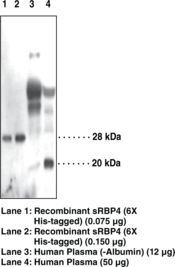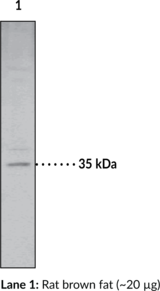Description
Serum retinol binding protein 4 (sRBP4) binds one equivalent of vitamin A and is one of the major retinol carriers found in the blood of mammals.{14372, 14373} Human RBP4 is a monomeric 21 kDa β-sheet-rich protein that contains three disulfide bonds and belongs to the lipocalin protein family.{14379} sRBP4 is synthesized and sequestered in hepatocytes until retinol binding triggers its secretion.{14379} In plasma, sRBP4 typically forms a 1:1 complex with the 55 kDa tetrameric protein transthyretin (TTR) which prevents RBP from being removed from the plasma by glomerular filtration.{14378} Recent studies have shown that sRBP4 is an adipocyte-derived “signal” that may contribute to the pathogenesis of type 2 diabetes.{14371, 14380} Elevation of sRBP4 causes systemic insulin resistance whereas reduction of serum concentrations improves insulin action.{14371, 14376, 14374} The highest known concentrations of this protein exist in serum, liver, and skeletal muscle.{14374,14375,149371}
Synonyms: Plasma Retinol Binding Protein 4|pRBP|sRBP4
Immunogen: human sRBP4 amino acids 28-37 (RVKENFDKAR)
Formulation: Peptide affinity-purified IgG
Isotype:
Applications: WB
Origin: Animal/Rabbit
Stability: 365 days
Application|Western Blot||Product Type|Antibodies|Polyclonal Antibodies||Research Area|Endocrinology & Metabolism|Metabolic Diseases|Diabetes||Research Area|Endocrinology & Metabolism|Metabolic Diseases|Obesity


